

Compact Muon Solenoid
LHC, CERN
| CMS-B2G-16-001 ; CERN-EP-2016-326 | ||
| Search for single production of vector-like quarks decaying to a Z boson and a top or a bottom quark in proton-proton collisions at $\sqrt{s} = $ 13 TeV | ||
| CMS Collaboration | ||
| 25 January 2017 | ||
| JHEP 05 (2017) 029 | ||
| Abstract: A search for single production of vector-like quarks, T and B, decaying into a Z boson and a top or a bottom quark, respectively, is presented. The search is performed using data collected by the CMS experiment at the LHC in proton-proton collisions at $\sqrt{s}=$ 13 TeV, corresponding to an integrated luminosity of 2.3 fb$^{-1}$. An exotic T quark production mode through the decay of a heavy Z' resonance is also considered. The search is performed in events with a Z boson decaying leptonically, accompanied by a bottom or a top quark decaying hadronically. No excess of events is observed over the standard model background expectation. Products of production cross section and branching fraction for T and B quarks from 1.26 and 0.13 pb are excluded at 95% confidence level for the range of resonance mass considered, which is between 0.7 and 1.7 TeV. Limits on the product of the Z' boson production cross section and branching fraction, with the Z' boson decaying to the Tt final state, are set between 0.31 and 0.13 pb, for Z' boson masses in the range from 1.5 to 2.5 TeV. This is the first search at 13 TeV for single production of vector-like quarks in events with a Z boson decaying leptonically accompanied by boosted jets. | ||
| Links: e-print arXiv:1701.07409 [hep-ex] (PDF) ; CDS record ; inSPIRE record ; CADI line (restricted) ; | ||
| Figures | |

png pdf |
Figure 1:
Leading order Feynman diagrams for the production of a single T (B) vector-like quark and its decay to a Z boson and a t (b) quark on the left (center) and production of a Z' boson decaying to Tt on the right. |

png pdf |
Figure 1-a:
Leading order Feynman diagram for the production of a single T vector-like quark and its decay to a Z boson and a t quark. |

png pdf |
Figure 1-b:
Leading order Feynman diagram for the production of a single B vector-like quark and its decay to a Z boson and a b quark. |
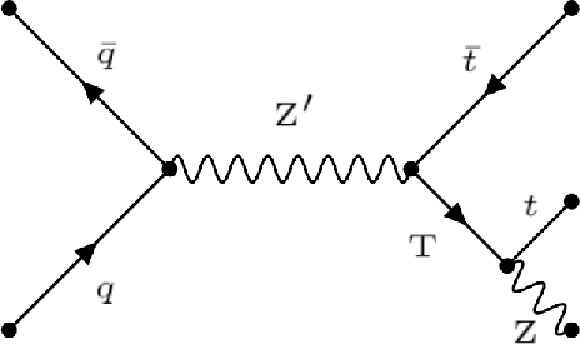
png pdf |
Figure 1-c:
Leading order Feynman diagram for the production of a Z' boson decaying to Tt. |
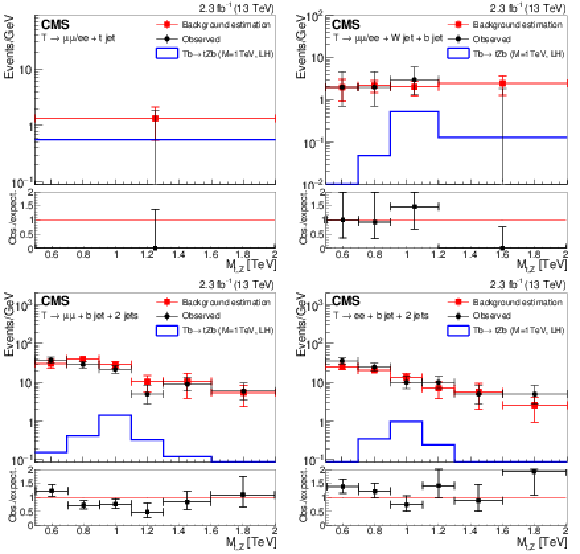
png pdf |
Figure 2:
Comparison between the background estimate and data for the T categories: fully merged region (upper-left), partially merged region (upper right), and resolved region (lower) for events with the Z boson decaying into muons (left) and electrons (right). For the fully and partially merged topologies, the sets of events with the Z boson decaying to muons and electrons are combined. For the fully merged region a shape analysis is not performed because of the small number of events, and a single bin is shown. The uncertainties in the background estimate method include both statistical and systematic components, as described in Section 6. The lower panel in each plot shows the ratio of the data and the background estimation, with the shaded band representing the uncertainties in the background estimate. |
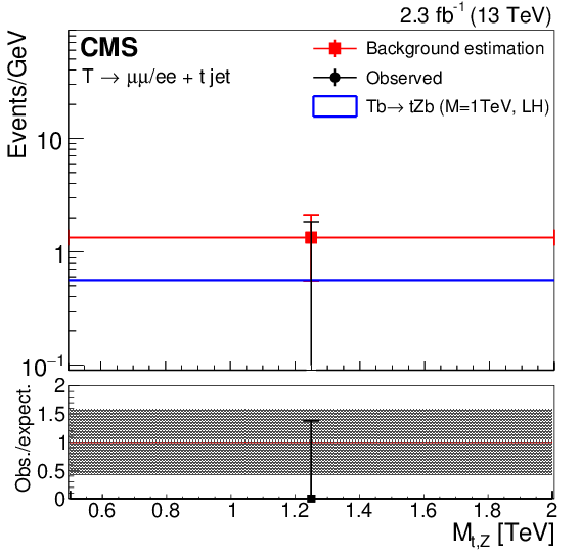
png pdf |
Figure 2-a:
Comparison between the background estimate and data for the fully merged region. The sets of events with the Z boson decaying to muons and electrons are combined. A shape analysis is not performed because of the small number of events, and a single bin is shown. The uncertainties in the background estimate method include both statistical and systematic components, as described in Section 6. The lower panel shows the ratio of the data and the background estimation, with the shaded band representing the uncertainties in the background estimate. |
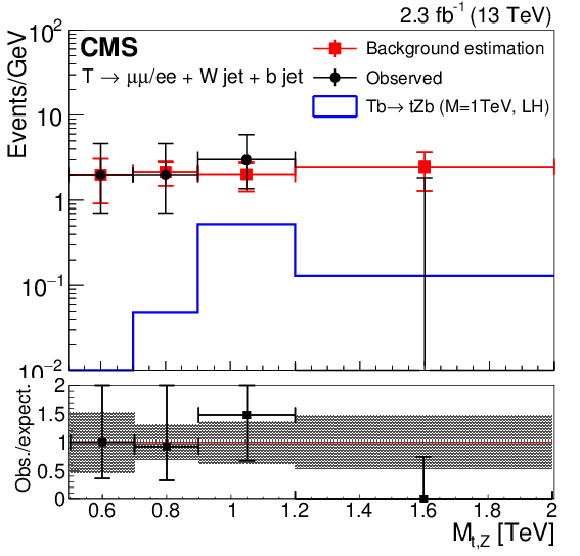
png pdf |
Figure 2-b:
Comparison between the background estimate and data for the partially merged region. The sets of events with the Z boson decaying to muons and electrons are combined. The uncertainties in the background estimate method include both statistical and systematic components, as described in Section 6. The lower panel shows the ratio of the data and the background estimation, with the shaded band representing the uncertainties in the background estimate. |
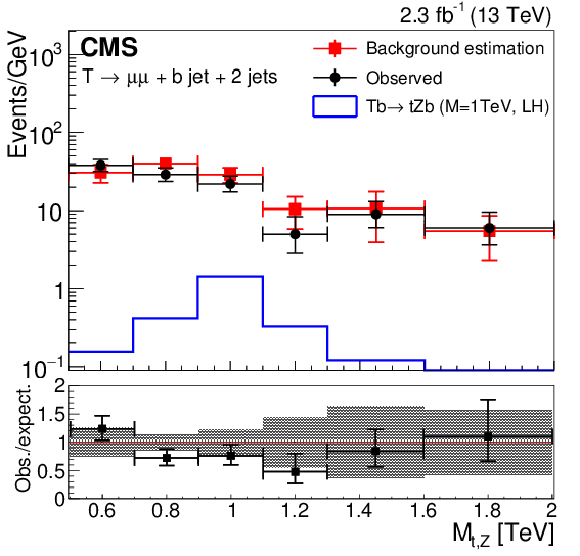
png pdf |
Figure 2-c:
Comparison between the background estimate and data for the resolved region for events with the Z boson decaying into muons. The uncertainties in the background estimate method include both statistical and systematic components, as described in Section 6. The lower panel shows the ratio of the data and the background estimation, with the shaded band representing the uncertainties in the background estimate. |
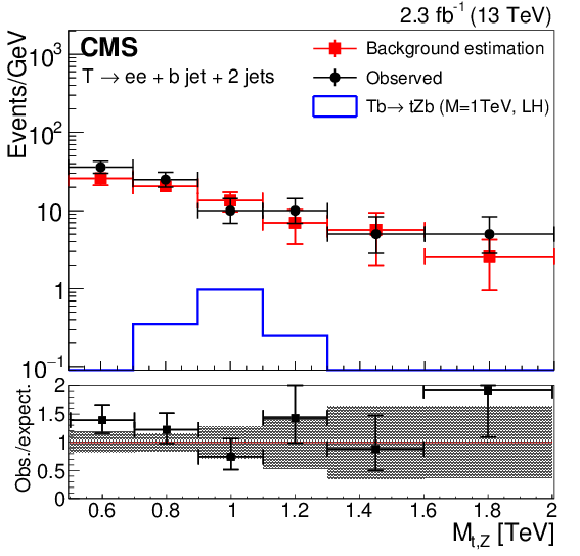
png pdf |
Figure 2-d:
Comparison between the background estimate and data for the resolved region for events with the Z boson decaying into electrons. The uncertainties in the background estimate method include both statistical and systematic components, as described in Section 6. The lower panel shows the ratio of the data and the background estimation, with the shaded band representing the uncertainties in the background estimate. |
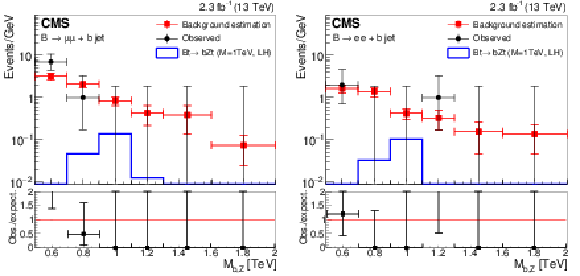
png pdf |
Figure 3:
Comparison between the background estimate and data for the B search categories: events with the Z boson decaying to muons (left) and to electrons (right). The uncertainties in the background estimate include both statistical and systematic components, as described in Section 6. The lower panel in each plot shows the ratio of the data and the background estimation, with the shaded band representing the uncertainties in the background estimate. |
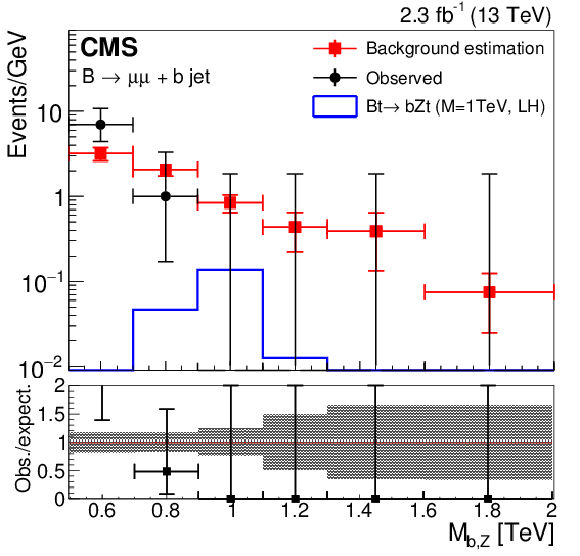
png pdf |
Figure 3-a:
Comparison between the background estimate and data for the B search categories: events with the Z boson decaying to muons. The uncertainties in the background estimate include both statistical and systematic components, as described in Section 6. The lower panel shows the ratio of the data and the background estimation, with the shaded band representing the uncertainties in the background estimate. |

png pdf |
Figure 3-b:
Comparison between the background estimate and data for the B search categories: events with the Z boson decaying to electrons. The uncertainties in the background estimate include both statistical and systematic components, as described in Section 6. The lower panel shows the ratio of the data and the background estimation, with the shaded band representing the uncertainties in the background estimate. |

png pdf |
Figure 4:
Observed and expected 95% CL upper limit on the product of cross section and branching fraction for the singlet LH T(b) (left) and doublet RH T(t) (right) production modes, with the T decaying to tZ. The 68% and 95% expected bands are shown. Theoretical cross sections as calculated at NLO in Ref. [12] are shown. The branching fraction $\mathcal {B} (\mathrm{ T\to tZ} )$ is 0.25 (0.5) for the left (right) plot. |
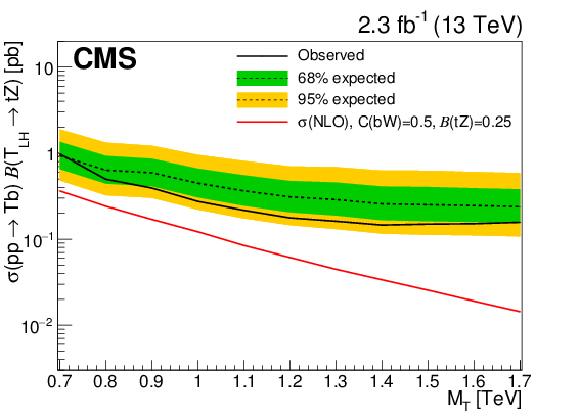
png pdf |
Figure 4-a:
Observed and expected 95% CL upper limit on the product of cross section and branching fraction for the singlet LH T(b) production mode, with the T decaying to tZ. The 68% and 95% expected bands are shown. Theoretical cross sections as calculated at NLO in Ref. [12] are shown. The branching fraction $\mathcal {B} (\mathrm{ T\to tZ} )$ is taken as 0.25. |
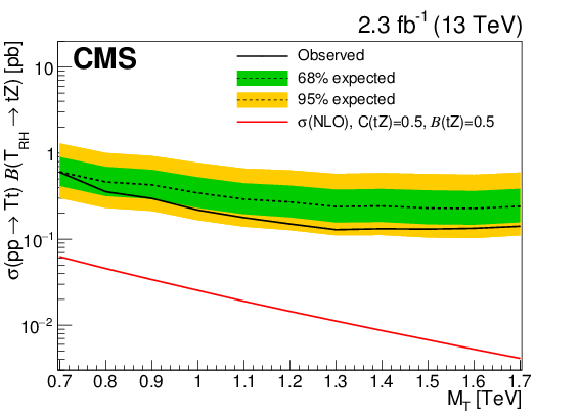
png pdf |
Figure 4-b:
Observed and expected 95% CL upper limit on the product of cross section and branching fraction for the doublet RH T(t) production modes, with the T decaying to tZ. The 68% and 95% expected bands are shown. Theoretical cross sections as calculated at NLO in Ref. [12] are shown. The branching fraction $\mathcal {B} (\mathrm{ T\to tZ} )$ is taken as 0.5. |
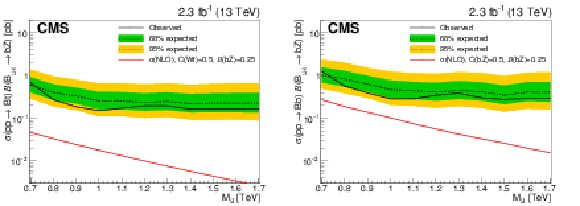
png pdf |
Figure 5:
Observed and expected 95% CL upper limit on the product of cross section and branching fraction for the B(t) (left) and B(b) (right) signals in the singlet LH scenario, with the B decaying to bZ. The 68% and 95% expected bands are shown. Theoretical cross sections as calculated at NLO in Ref. [12] are shown. The branching fraction $\mathcal {B}(\mathrm{B} \to \mathrm{ b } {\mathrm{ Z } } )$ is 0.25. |
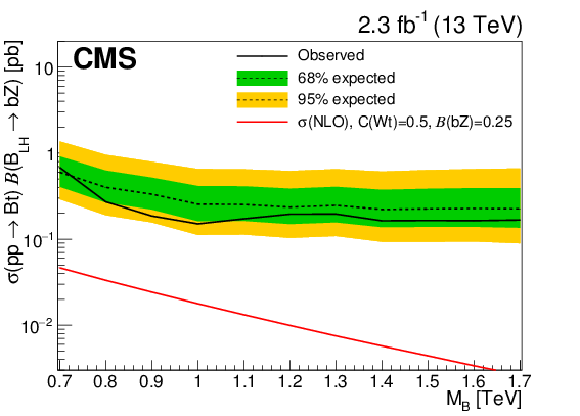
png pdf |
Figure 5-a:
Observed and expected 95% CL upper limit on the product of cross section and branching fraction for the B(t) signal in the singlet LH scenario, with the B decaying to bZ. The 68% and 95% expected bands are shown. Theoretical cross sections as calculated at NLO in Ref. [12] are shown. The branching fraction $\mathcal {B}(\mathrm{B} \to \mathrm{ b } {\mathrm{ Z } } )$ is 0.25. |

png pdf |
Figure 5-b:
Observed and expected 95% CL upper limit on the product of cross section and branching fraction for the B(b) signal in the singlet LH scenario, with the B decaying to bZ. The 68% and 95% expected bands are shown. Theoretical cross sections as calculated at NLO in Ref. [12] are shown. The branching fraction $\mathcal {B}(\mathrm{B} \to \mathrm{ b } {\mathrm{ Z } } )$ is 0.25. |
| Tables | |

png pdf |
Table 1:
Theoretical cross sections for T(b), B(t), B(b), and T(t) processes for the different benchmark mass points considered in the analysis, with the couplings set to 0.5 as calculated at NLO in Ref. [12]. Cross sections do not depend on the chirality of the new particle (T or B). |

png pdf |
Table 2:
Summary of the final event selection for the four categories of the T search. In each category exactly two oppositely charged leptons are required. |
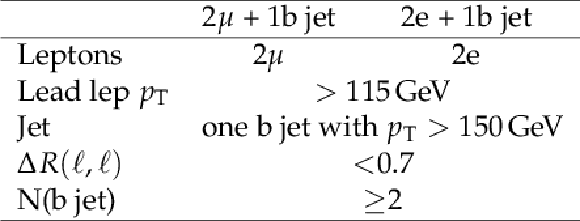
png pdf |
Table 3:
Summary of the final event selection for the two categories of the B search. In each category exactly two oppositely charged leptons are required. |

png pdf |
Table 4:
The numbers of estimated background events compared to the measured numbers of events for the four categories of the T search. The quoted uncertainties in the background estimates include both statistical and systematic components, as described in Section 6. Expected signal yields and signal efficiencies (in parentheses) are also shown for three benchmark mass points. |
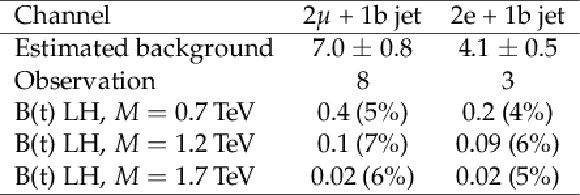
png pdf |
Table 5:
The numbers of estimated background events compared to the measured numbers of events for the two categories of the B search. The quoted uncertainties in the background estimates include both statistical and systematic components, as described in Section 6. Expected signal yields and signal efficiencies (in parentheses) are also shown for three benchmark mass points. |

png pdf |
Table 6:
Observed and expected 95% CL upper limit on $\sigma \mathcal {B}$ for the $\mathrm{ Z }' \to {\mathrm {T}} \mathrm{ t } $ signal. The branching fraction $\mathcal {B}( {\mathrm {T}} \to \mathrm{ t } {\mathrm{ Z } } )$ is taken to be 100%. In order to consider different branching fractions, the limits should be scaled by the corresponding branching fraction value. The 1 and 2 standard deviation bands are given. |
| Summary |
| Results of a search for single production of a T quark with a charge of $+2/3$ decaying to a Z boson and a top quark and of a search for single production of a B quark with a charge of $-1/3$ decaying to a b quark and a Z boson have been presented. No deviations from the expected standard model background are observed. Limits on the product of the cross section and branching fraction for a left-handed T(b), with the T quark decaying to tZ, vary between 0.98 and 0.15 pb at 95% confidence level and between 0.60 and 0.13 pb for a right-handed T(t) signal, for the range of resonance mass considered, which is between 0.7 and 1.7 TeV. For a left-handed B quark produced in association with a top quark and decaying to bZ, products of the cross section and branching fraction between 0.68 and 0.15 pb are excluded in the same mass range, while for a B quark produced in association with a bottom quark, products of the cross section and branching fraction between 1.26 and 0.28 pb are excluded. Additionally, products of the cross section and branching fraction for T quarks from the decay $\mathrm{ Z }'\to\mathrm{ T }\mathrm{ t }$ are excluded between 0.31 and 0.13 pb, for the range of Z' (T) mass considered, which is between 1.5 to 2.5 (0.7 to 1.5) TeV. This is the first search at 13 TeV for single production of vector-like quarks in events with a Z boson decaying leptonically accompanied by boosted jets. |
| References | ||||
| 1 | ATLAS Collaboration | Observation of a new particle in the search for the Standard Model Higgs boson with the ATLAS detector at the LHC | PLB 716 (2012) 1 | 1207.7214 |
| 2 | CMS Collaboration | Observation of a new boson at a mass of 125 GeV with the CMS experiment at the LHC | PLB 716 (2012) 30 | CMS-HIG-12-028 1207.7235 |
| 3 | CMS Collaboration | Observation of a new boson with mass near 125 GeV in pp collisions at $ \sqrt{s} = $ 7 and 8 TeV | JHEP 06 (2013) 081 | CMS-HIG-12-036 1303.4571 |
| 4 | ATLAS, CMS Collaboration | Combined Measurement of the Higgs Boson Mass in pp Collisions at $ \sqrt{s} = $ 7 and 8 TeV with the ATLAS and CMS Experiments | PRL 114 (2015) 191803 | 1503.07589 |
| 5 | M. Schmaltz and D. Tucker-Smith | Little Higgs review | Ann. Rev. Nucl. Part. Sci. 55 (2005) 229 | hep-ph/0502182 |
| 6 | I. Antoniadis, K. Benakli, and M. Quiros | Finite Higgs mass without supersymmetry | New J. Phys. 3 (2001) 20 | hep-th/0108005 |
| 7 | L. Randall and R. Sundrum | A Large Mass Hierarchy from a Small Extra Dimension | PRL 83 (1999) 3370 | hep-ph/9905221 |
| 8 | K. Agashe, R. Contino, and A. Pomarol | The minimal composite Higgs model | Nucl. Phys. B 719 (2005) 165 | hep-ph/0412089 |
| 9 | J. A. Aguilar-Saavedra, R. Benbrik, S. Heinemeyer, and M. Perez-Victoria | Handbook of vectorlike quarks: Mixing and single production | PRD 88 (2013) 094010 | 1306.0572 |
| 10 | J. A. Aguilar-Saavedra | Identifying top partners at LHC | JHEP 11 (2009) 030 | 0907.3155 |
| 11 | A. De Simone, O. Matsedonskyi, R. Rattazzi, and A. Wulzer | A first top partner hunter's guide | JHEP 04 (2013) 004 | 1211.5663 |
| 12 | O. Matsedonskyi, G. Panico, and A. Wulzer | On the interpretation of top partners searches | JHEP 12 (2014) 097 | 1409.0100 |
| 13 | M. Buchkremer, G. Cacciapaglia, A. Deandrea, and L. Panizzi | Model-independent framework for searches of top partners | Nucl. Phys. B 876 (2013) 376 | 1305.4172 |
| 14 | O. Eberhardt et al. | Joint analysis of Higgs decays and electroweak precision observables in the standard model with a sequential fourth generation | PRD 86 (2012) 013011 | 1204.3872 |
| 15 | ATLAS Collaboration | Search for production of vector-like quark pairs and of four top quarks in the lepton-plus-jets final state in pp collisions at $ \sqrt{s} = $ 8 TeV with the ATLAS detector | JHEP 08 (2015) 105 | 1505.04306 |
| 16 | ATLAS Collaboration | Search for vector-like B quarks in events with one isolated lepton, missing transverse momentum and jets at $ \sqrt{s}= $ 8 TeV with the ATLAS detector | PRD 91 (2015) 112011 | 1503.05425 |
| 17 | ATLAS Collaboration | Search for pair and single production of new heavy quarks that decay to a Z boson and a third-generation quark in pp collisions at $ \sqrt{s} = $ 8 TeV with the ATLAS detector | JHEP 11 (2014) 104 | 1409.5500 |
| 18 | ATLAS Collaboration | Search for single production of a vector-like quark via a heavy gluon in the 4b final state with the ATLAS detector in pp collisions at $ \sqrt{s} = $ 8 TeV | PLB 758 (2016) | 1602.06034 |
| 19 | ATLAS Collaboration | Search for single production of vector-like quarks decaying into $ Wb $ in $ pp $ collisions at $ \sqrt{s} = $ 8 TeV with the ATLAS detector | EPJC 76 (2016) 442 | 1602.05606 |
| 20 | ATLAS Collaboration | Search for the production of single vector-like and excited quarks in the $ Wt $ final state in $ pp $ collisions at $ \sqrt{s} = $ 8 TeV with the ATLAS detector | JHEP 02 (2016) 110 | 1510.02664 |
| 21 | CMS Collaboration | Search for vector-like charge $ 2/3\,T $ quarks in proton-proton collisions at $ \sqrt{(s)}=8 $ TeV | PRD 93 (2016) 012003 | CMS-B2G-13-005 1509.04177 |
| 22 | CMS Collaboration | Search for pair-produced vectorlike $ B $ quarks in proton-proton collisions at $ \sqrt{s} = $ 8 TeV | PRD 93 (2016) 112009 | CMS-B2G-13-006 1507.07129 |
| 23 | CMS Collaboration | Search for Top-Quark Partners with Charge 5/3 in the Same-Sign Dilepton Final State | PRL 112 (2014) 171801 | CMS-B2G-12-012 1312.2391 |
| 24 | CMS Collaboration | Search for single production of a heavy vector-like T quark decaying to a Higgs boson and a top quark with a lepton and jets in the final state | Submitted to PLB | CMS-B2G-15-008 1612.00999 |
| 25 | B. W. Lee, C. Quigg, and H. B. Thacker | Weak interactions at very high-energies: the role of the Higgs boson mass | PRD 16 (1977) 1519 | |
| 26 | C. Bini, R. Contino, and N. Vignaroli | Heavy-light decay topologies as a new strategy to discover a heavy gluon | JHEP 01 (2012) 157 | 1110.6058 |
| 27 | E. Accomando et al. | Z' physics with early LHC data | PRD 83 (2011) 075012 | 1010.6058 |
| 28 | D. Greco and D. Liu | Hunting composite vector resonances at the LHC: naturalness facing data | JHEP 12 (2014) 126 | 1410.2883 |
| 29 | CMS Collaboration | Search for massive resonances decaying into pairs of boosted bosons in semi-leptonic final states at $ \sqrt{s} = $ 8 TeV | JHEP 08 (2014) 174 | CMS-EXO-13-009 1405.3447 |
| 30 | CMS Collaboration | Search for vector-like T quarks decaying to top quarks and Higgs bosons in the all-hadronic channel using jet substructure | JHEP 06 (2015) 080 | CMS-B2G-14-002 1503.01952 |
| 31 | CMS Collaboration | The CMS experiment at the CERN LHC | JINST 3 (2008) S08004 | CMS-00-001 |
| 32 | J. Alwall et al. | The automated computation of tree-level and next-to-leading order differential cross sections, and their matching to parton shower simulations | JHEP 07 (2014) 079 | 1405.0301 |
| 33 | P. Nason | A new method for combining NLO QCD with shower Monte Carlo algorithms | JHEP 11 (2004) 040 | hep-ph/0409146 |
| 34 | S. Frixione, P. Nason, and C. Oleari | Matching NLO QCD computations with Parton Shower simulations: the POWHEG method | JHEP 11 (2007) 070 | 0709.2092 |
| 35 | S. Alioli, P. Nason, C. Oleari, and E. Re | A general framework for implementing NLO calculations in shower Monte Carlo programs: the POWHEG BOX | JHEP 06 (2010) 043 | 1002.2581 |
| 36 | S. Alioli, S.-O. Moch, and P. Uwer | Hadronic top-quark pair-production with one jet and parton showering | JHEP 01 (2012) 137 | 1110.5251 |
| 37 | T. Sj\"ostrand et al. | An introduction to PYTHIA 8.2 | CPC 191 (2015) 159 | 1410.3012 |
| 38 | CMS Collaboration | Event generator tunes obtained from underlying event and multiparton scattering measurements | EPJC 76 (2016) 155 | CMS-GEN-14-001 1512.00815 |
| 39 | GEANT4 Collaboration | GEANT4---a simulation toolkit | NIMA 506 (2003) 250 | |
| 40 | J. Allison et al. | Geant4 developments and applications | IEEE Trans. Nucl. Sci. 53 (2006) 270 | |
| 41 | NNPDF Collaboration | Parton distributions for the LHC Run II | JHEP 04 (2015) 040 | 1410.8849 |
| 42 | CMS Collaboration | Description and performance of track and primary-vertex reconstruction with the CMS tracker | JINST 9 (2014) P10009 | CMS-TRK-11-001 1405.6569 |
| 43 | CMS Collaboration | Particle-flow event reconstruction in CMS and performance for jets, taus, and $ E_{\mathrm{T}}^{\text{miss}} $ | CDS | |
| 44 | CMS Collaboration | Commissioning of the particle-flow event with the first LHC collisions recorded in the CMS detector | CDS | |
| 45 | CMS Collaboration | Performance of CMS muon reconstruction in pp collision events at $ \sqrt{s} = $ 7 TeV | JINST 7 (2012) P10002 | CMS-MUO-10-004 1206.4071 |
| 46 | CMS Collaboration | Performance of electron reconstruction and selection with the CMS detector in proton-proton collisions at $ \sqrt{s} = $ 8 TeV | JINST 10 (2015) P06005 | CMS-EGM-13-001 1502.02701 |
| 47 | M. Cacciari, G. P. Salam, and G. Soyez | The anti-$ k_{t} $ jet clustering algorithm | JHEP 04 (2008) 063 | 0802.1189 |
| 48 | S. D. Ellis, C. K. Vermilion, and J. R. Walsh | Techniques for improved heavy particle searches with jet substructure | PRD 80 (2009) 051501 | 0903.5081 |
| 49 | CMS Collaboration | Identification techniques for highly boosted W bosons that decay into hadrons | JHEP 12 (2014) 017 | CMS-JME-13-006 1410.4227 |
| 50 | CMS Collaboration | Search for massive resonances in dijet systems containing jets tagged as W or Z boson decays in pp collisions at $ \sqrt{s} = $ 8 TeV | JHEP 08 (2014) 173 | CMS-EXO-12-024 1405.1994 |
| 51 | CMS Collaboration | Search for Narrow Resonances Decaying to Dijets in Proton-Proton Collisions at $ \sqrt{s} =13 $$ TeV $ | PRL 116 (2016) 071801 | CMS-EXO-15-001 1512.01224 |
| 52 | M. Dasgupta, A. Fregoso, S. Marzani, and G. P. Salam | Towards an understanding of jet substructure | JHEP 09 (2013) 029 | 1307.0007 |
| 53 | A. J. Larkoski, S. Marzani, G. Soyez, and J. Thaler | Soft drop | JHEP 05 (2014) 146 | 1402.2657 |
| 54 | CMS Collaboration | Identification of b quark jets at the CMS Experiment in the LHC Run 2 | CMS-PAS-BTV-15-001 | CMS-PAS-BTV-15-001 |
| 55 | CMS Collaboration | Identification of b-quark jets with the CMS experiment | JINST 8 (2013) P04013 | CMS-BTV-12-001 1211.4462 |
| 56 | CMS Collaboration | Measurement of the production cross sections for a Z boson and one or more b jets in pp collisions at $ \sqrt{s} = $ 7 TeV | JHEP 06 (2014) 120 | CMS-SMP-13-004 1402.1521 |
| 57 | J. Butterworth et al. | PDF4LHC recommendations for LHC Run II | JPG 43 (2016) 023001 | 1510.03865 |
| 58 | ATLAS Collaboration | Measurement of the Inelastic Proton-Proton Cross Section at $ \sqrt{s} = $ 13 TeV with the ATLAS Detector at the LHC | PRL 117 (2016) 182002 | 1606.02625 |
| 59 | CMS Collaboration | CMS Luminosity Measurement for the 2015 Data Taking Period | CMS-PAS-LUM-15-001 | CMS-PAS-LUM-15-001 |
| 60 | A. L. Read | Presentation of search results: the $ CL_s $ technique | JPG 28 (2002) 2693 | |
| 61 | T. Junk | Confidence level computation for combining searches with small statistics | NIMA 434 (1999) 435 | hep-ex/9902006 |
| 62 | G. Cowan, K. Cranmer, E. Gross, and O. Vitells | Asymptotic formulae for likelihood-based tests of new physics | EPJC 71 (2011) 1554 | 1007.1727 |
| 63 | ATLAS and CMS Collaboration | Procedure for the LHC Higgs boson search combination in summer 2011 | CMS-NOTE-2011-005 | |

|
Compact Muon Solenoid LHC, CERN |

|

|

|

|

|

|